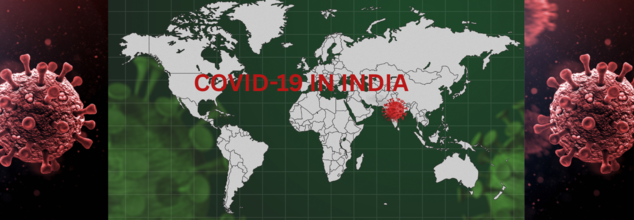- Health Conditions A-Z
- Health & Wellness
- Nutrition
- Fitness
- Health News
- Ayurveda
- Videos
- Medicine A-Z
- Parenting
- Web Stories
23 New Covid Cases In Delhi, Health Minister Issues Advisory

Credits: Canva
New Delhi is witnessing a modest increase in COVID-19 cases, with 23 active infections reported as of May 22, Health Minister Dr. Pankaj Singh confirmed on Friday. Emphasizing that there is no reason to panic, Singh said all patients are currently stable. “Two to three patients are admitted to private hospitals while the others are being monitored. We will verify if these patients are residents of Delhi or from outside. The strain is similar to influenza,” he noted.
The minister also reassured the public about the state’s preparedness. “We’ve had conversations with medical superintendents. Eight senior officials are visiting hospitals daily to ensure everything is in order. Our hospitals are equipped with oxygen, oximeters, and essential medical supplies,” Singh added.
In line with this, the Delhi health department has instructed all private and government hospitals to ensure the availability of beds, oxygen, essential medicines, and vaccines. An advisory will be issued shortly to provide further guidance.
Omicron Sub-Variants Fuel Regional and Global Spike
The rise in COVID-19 cases in Delhi and other Indian states comes after a spike was observed in several Asian countries. Health authorities have attributed the increase to Omicron-related sub-variants—primarily LF.7 and NB.1.8—descendants of the JN.1 variant, which in turn evolved from the BA.2.86 (Pirola) strain.
These sub-lineages are known for their high transmissibility but relatively mild symptoms. Despite the rise, experts maintain that the current wave is manageable and no immediate threat of severe disease has been identified.
Advisory To Hospitals
In an internal order, Delhi’s health department directed all hospitals to ensure critical equipment like ventilators, BiPAP machines, and oxygen concentrators are functional. Staff are being asked to undergo refresher training, and all hospitals must report Influenza-like Illness (ILI) and Severe Acute Respiratory Illness (SARI) cases daily on the Integrated Health Information Platform (IHIP).
Additionally, 5% of ILI cases and 100% of SARI cases must undergo COVID-19 testing, in accordance with ICMR guidelines. Positive samples are to be sent to Lok Nayak Hospital for genome sequencing to detect any emerging variants.
Neighboring States And Others Also Report Mild Cases
Haryana: Two mild COVID-19 cases were reported in Gurgaon—a 62-year-old man and a 31-year-old woman who had recently travelled from Mumbai. Both are in home isolation. Meanwhile, a 28-year-old security guard from Faridabad tested positive at Delhi’s Safdarjung Hospital. None had a travel history abroad or known contact with infected persons. Health officials emphasized that these are isolated, mild cases and do not indicate a severe outbreak.
Maharashtra: The state has reported 95 new COVID-19 cases in Mumbai this month, with a total of 106 since January. At least 16 patients are hospitalized, mostly shifted to Seven Hills Hospital from KEM Hospital. Pune, although not reporting any active cases currently, has reserved 50 beds at Naidu Hospital as a precautionary step.
Tamil Nadu: In Chennai and Puducherry, health officials are seeing a shift in viral diagnosis, where fevers initially linked to influenza are now being identified as COVID-19. Public Health Director Dr. TS Selvavinayagam has urged caution in crowded places but reassured the public not to panic.
Karnataka: The state currently has 16 active COVID-19 cases, confirmed by Health Minister Dinesh Gundu Rao.
Gujarat: Seven new cases were reported in Ahmedabad in a single day—a sharp spike for a city that has averaged one case per month over the past year. All patients are in home isolation, and their samples have been sent for genomic sequencing. Officials say the infections are from the JN.1 variant and are mild in nature.
International Spike
Singapore and Hong Kong are witnessing a noticeable surge in COVID-19 cases, primarily driven by LF.7 and NB.1.8 sub-variants. Singapore’s Ministry of Health has urged citizens to get vaccinated, especially those who haven’t received their initial doses. Hong Kong has reached its highest case numbers in over a year and is encouraging mask-wearing and crowd avoidance.
What Are the Current Symptoms?
Unlike earlier variants, the current wave presents some slightly different symptoms. While cough and sore throat remain common, additional symptoms include nausea, vomiting, brain fog, and conjunctivitis. Most cases are mild, but health authorities advise individuals to monitor symptoms and seek medical attention if needed.
Scientists Develop Device That Helps Humans 'See In Dark'—Even With Eyes Closed

Credits: Canva
In a scientific breakthrough that blurs the line between fiction and medicine, Chinese scientists have developed soft, invisible contact lenses that allow humans to see near-infrared light—a hitherto invisible spectrum to the naked eye. This innovation is not only non-surgical but also effective in complete darkness, even with the eyes closed. The results from the study, which were released in the high-profile journal Cell, represent a major advance in wearable "super-vision" technology that can potentially revolutionize medical imaging, search and rescue, and vision aid for the blind.
Human eyes are biologically restricted to detecting only wavelengths of light between 400 and 700 nanometers—a slim range that accounts for only a part of the electromagnetic spectrum. Yet, near-infrared light, from 700 to 2,500 nanometers, penetrates more deeply and harmlessly through biological tissues, holding immense promise in the fields of early disease detection and non-invasive imaging.
Directed by University of Science and Technology of China neuroscientist Dr. Tian Xue, the scientists aimed to design a lens that would be able to overcome such natural restrictions. The solution lies in rare earth nanoparticles—tiny particles with the ability to absorb invisible infrared light and re-transmit it as visible red, green, or blue light. These nanoparticles, namely sodium gadolinium fluoride doped with ytterbium, erbium, and gold, were designed to operate safely and effectively within soft contact lenses.
How These Lenses Work?
This is not the first time the research group has made infrared vision more than just a fantasy. Previously, in previous experiments, they directly injected infrared-sensitive nanomaterials into the retinas of test animals, offering them night vision for a limited time. But because retinal injections were so invasive, attention soon turned to a less invasive approach: contact lenses.
By dispersing the nanoparticles of rare earth into polymer solutions that are biocompatible with human eyes, the researchers were able to create ultra-thin, see-through lenses. The lenses were tried out in mice and then in human volunteers. Tests proved that the wearers could identify flickering infrared radiation, recognize infrared patterns, and even decipher temporal codes—even though the light itself was completely undetectable by the human eye when it is not covered by lenses.
One surprising development? Human subjects showed even stronger definition in picking up infrared light when their eyes were shut. In the opinion of Dr. Xue, "Near-infrared light penetrates eyelids more efficiently than visible light, allowing for improved signal detection with eyes shut—free from visible light interference."
Seeing What the Naked Eye Misses?
Older night-vision goggles, introduced during World War II, use electronic image intensifiers and need lots of power to run. These goggles are big, give off greenish images, and usually have difficulty identifying finer details at longer wavelengths of infrared. The newly created lenses, however, work without the need for an external power source and provide a more natural visual output. They are so light and transparent that they are potential rivals for real-life, everyday use in troublesome visual conditions such as fog, dust, or nighttime.
Can These Lenses Assist the Color Blind to See Better?
Although currently in the proof-of-concept phase, this technology's applicability is vast and extensive. The following are some of the possible uses:
Medical imaging: Increased visibility of tissues during surgery or scans
Vision enhancement: Aiding people with visual deficiencies or color blindness
Security & surveillance: Infrared pattern recognition for clandestine communication
Search and rescue: Locating persons or objects under low-visibility conditions
Anti-counterfeiting: Decoding flickering infrared security codes that cannot be seen with the human eye
For colorblind people, the group even prototyped a model of the lenses that converted components of the visible red spectrum to green or blue light, possibly allowing users to differentiate colors previously invisible to them. "This could make the invisible visible," said Dr. Xue, as he points out its possibility of improving daily life for millions.
Although its potential is great, the technology has challenges to overcome before it can be sold commercially. As of now, the lenses can pick up only intense infrared signals from LED light sources. Increasing their sensitivity to ambient or low-intensity light is a key next step. Additionally, since contact lenses are near the retina, their potential to read fine details in an image is low.
To overcome this, the scientists are developing a wearable glass system using the same nanotechnology but with greater field of vision and better image quality. The aim is to develop a hybrid wearable that offers the convenience of lenses coupled with clarity and detail for complex tasks.
This revolutionary technology is a paradigm shift in the way that humans may engage with their environment. By literally broadening the visible spectrum, the innovation provides new modes for perceiving, reacting to, and comprehending our world—particularly in situations where sight has historically been impaired.
Whether wielded by surgeons, search and rescue crews, or people moving through a blacked-out terrain, the possibilities of night-vision contact lenses are staggering. As Dr. Xue summed up, "Our research opens up the potential for non-invasive wearable devices to give people super-vision."
Nine-month-old Child Tested Positive For Covid-19 In Bengaluru

Credits: Canva
A nine-month-old baby boy from Hoskote in Bengaluru Rural district has tested positive for Covid-19, according to Karnataka’s Health and Family Welfare Department. The infant was initially taken to a private hospital but later transferred to Vani Vilas Hospital in Kalasipalya, Bengaluru, for specialized care.
The child tested positive through a Rapid Antigen Test conducted on May 22. Officials confirmed that the baby is in stable condition and under close medical observation. Doctors at the hospital say he is responding well to treatment.
Covid-19 Situation in Karnataka
The case comes at a time when Karnataka is witnessing a slight but noticeable increase in Covid-19 cases. As of now, the state has 35 active infections, with 32 of them reported in Bengaluru alone. So far, no fatalities have been linked to the recent surge.
Health authorities noted a gradual uptick in cases over the last 20 days, prompting reminders to the public to follow Covid safety protocols. People have been advised to wear masks in crowded places, maintain hygiene, and avoid unnecessary gatherings—particularly in cities like Bengaluru, where the majority of cases are being reported.
Rise in Cases in Kerala
Neighbouring Kerala has experienced a sharper rise in infections this month, with 182 confirmed cases so far. The state’s Health Minister has urged residents to remain alert and take precautionary measures. Among the districts, Kottayam has recorded the highest number of infections (57), followed by Ernakulam (34) and Thiruvananthapuram (30).
In response, Kerala’s health authorities have stepped up public messaging to promote early testing and isolation to limit the spread of the virus.
ALSO READ: 23 New Covid Cases In Delhi, Health Minister Issues Advisory
Andhra Pradesh Issues Public Advisory
In Andhra Pradesh, the Health Department released a public advisory on May 22 following indications of a rise in Covid-19 cases. Although specific figures have not been released, officials have recommended that people stay cautious, get tested if they show symptoms, and continue following preventive practices such as masking and hand hygiene.
Advisory For Delhi Hospitals
In an internal order, Delhi’s health department directed all hospitals to ensure critical equipment like ventilators, BiPAP machines, and oxygen concentrators are functional. Staff are being asked to undergo refresher training, and all hospitals must report Influenza-like Illness (ILI) and Severe Acute Respiratory Illness (SARI) cases daily on the Integrated Health Information Platform (IHIP).
Additionally, 5% of ILI cases and 100% of SARI cases must undergo COVID-19 testing, in accordance with ICMR guidelines. Positive samples are to be sent to Lok Nayak Hospital for genome sequencing to detect any emerging variants.
Cases Originally From Singapore And Hong Kong
Singapore and Hong Kong are witnessing a noticeable surge in COVID-19 cases, primarily driven by LF.7 and NB.1.8 sub-variants. Singapore’s Ministry of Health has urged citizens to get vaccinated, especially those who haven’t received their initial doses. Hong Kong has reached its highest case numbers in over a year and is encouraging mask-wearing and crowd avoidance.
What Are the Current Symptoms?
Unlike earlier variants, the current wave presents some slightly different symptoms. While cough and sore throat remain common, additional symptoms include nausea, vomiting, brain fog, and conjunctivitis. Most cases are mild, but health authorities advise individuals to monitor symptoms and seek medical attention if needed.
FDA Greenlights Nucala as New Treatment for COPD

Credits: Canva
The U.S. Food and Drug Administration (FDA) has approved Nucala (mepolizumab) as an add-on maintenance treatment for adults with chronic obstructive pulmonary disease (COPD) that remains inadequately controlled despite existing therapies. The approval offers new hope to patients whose symptoms persist despite being on inhaled triple therapy.
What is COPD?
According to the World Health Organization (WHO), COPD is a common, preventable, and treatable disease that is characterized by persistent respiratory symptoms and airflow limitation due to airway and/or alveolar abnormalities. It typically results from significant exposure to noxious particles or gases.
Symptoms of COPD include:
- Chronic cough
- Shortness of breath
- Wheezing
- Chest tightness
- Excess mucus production
Causes of COPD range from long-term smoking and air pollution exposure to occupational dusts and fumes. Genetics and respiratory infections in early life can also contribute.
COPD is progressive and often worsens over time, severely impacting quality of life. One of the most critical challenges in managing the condition is reducing exacerbations—flare-ups that may require hospitalization or emergency treatment.
Why Nucala Matters
Nucala is the only approved biologic that has been specifically studied in COPD patients with an eosinophilic phenotype defined by a blood eosinophil count (BEC) of ≥150 cells/μL. This is important because up to 70% of U.S. COPD patients who are not adequately managed on inhaled triple therapy fall into this category.
Biologics like Nucala work by targeting specific pathways in the immune system. Mepolizumab, the active ingredient in Nucala, is an anti-IL-5 monoclonal antibody that reduces eosinophilic inflammation—a key contributor to COPD exacerbations in certain patients.
Clinical Trial Evidence
The FDA’s approval of Nucala is based on results from two large Phase 3 clinical trials, MATINEE and METREX, which evaluated its use alongside optimal inhaled therapy. Both were randomized, double-blind, and placebo-controlled.
In the MATINEE trial, involving 804 patients with a BEC ≥300 cells/μL, Nucala showed:
A significant reduction in moderate or severe exacerbations: 0.80 vs 1.01 events/year (rate ratio, 0.79).
A 35% decrease in emergency visits or hospitalizations for COPD exacerbations (rate ratio, 0.65).
The METREX trial produced similar outcomes. Patients on Nucala had:
Fewer moderate or severe exacerbations: 1.40 vs 1.71 events/year (rate ratio, 0.82).
Adverse events were comparable between the Nucala and placebo groups, suggesting a favorable safety profile.
A New Era for COPD Management
“COPD isn't just a disease, it's a relentless cycle,” said Dr. Jean Wright, CEO of the COPD Foundation. “Even with current therapies, managing exacerbations remains a daily battle. Biologics like mepolizumab offer new hope.”
The FDA approval was granted to GSK, the pharmaceutical company that developed Nucala. With this decision, clinicians now have a novel option for patients with eosinophilic COPD who are still struggling despite standard treatment.
© 2024 Bennett, Coleman & Company Limited

